- Welcome
- Use case
- Getting Started
-
Searching Records
- Performing a Basic Search
- Performing an Advanced Search
- Performing a List Search
- Performing a Keyword Search of UUMC Pathology Reports for all Patients in the Database
- Performing a Keyword Search of UUMC Pathology Reports for the Patients Associated with a Specific Set of Specimens
- Restrictions on Searches
- Reports
-
iQ Tool
- Adding Columns to a Query
- Starting the iQ Tool
- iQ Tool Window
- Current Query Data Group
- Saved Queries List
- Top Portion of the Selected
- Display or Report Columns Section
- Find/Filters Section
- Running a Preexisting Query
- Creating a Query
- Create Query Window
- Copying and Altering a Preexisting Query
- Removing Columns from a Query
- Editing Column Parameters in a Query
- Changing the Order of Columns in a Query
- Adding Filters to a Query
- Editing Filters in a Query
- Ways of Comparing Data
- Removing Filters From a Query
- Results Window
- Application Data Structure
- Application Database Fields Alphabetical List
- Application Datatree
- Field Paths List for the iQ Tool
-
Adding Specimens to the Database
- Adding a Single Specimen using the Add Specimen Wizard
- Adding a Batch of Specimens using the Add Specimen Expert Tool
- Saving a Batch of Specimens to be added as a Work in Progress
- Finishing a Work in Progress Batch
- Printing Barcodes for a Specimens in a Batch added using the Add Specimen Expert Tool
- Customizing the Add Specimen Expert Tool to Streamline Specimen Batch Entry
- Changing which Box an Add Expert Template Points for Adding Storage
- Importing FFPE Samples from UUMC
- Entering and Editing Specimen Records
- Transformations
- Specimen Disbursement and Registration
- Reports and Records
- Adding a Pathology Report to a Specimen Record
- Performing a DEXT Import of a Pathology Import
- Checking on the status of your DEXT Import Request
- Adding a Medical Record to a Specimen Record
- Editing Patient or Collection Records
- Editing Collection Records
- Editing Patient Records
- Diagnoses
- Adding a Diagnosis to a Patient Record
- Linking an Existing Diagnosis to one or more Collections
- Linking a Collection to a Diagnosis
- Recording a Consent for a Patient
- Reviewing a Patient's Consents
- Uploading a Patient's Consent Form
- Managing Patient Consents
- External (to itBioPath) Data Sources
- Managing Dictionaries
-
Storage
- Editing Aliquots
- Connecting a Barcode Label Printer to itBioPath
- Removing a Barcode Label Printer from itBioPath
- Freezer Management
- Viewing the Contents of a Box in a Freezer
- Accessing the Specimen Record for the Specimen associated with an Aliquot
- Editing Box Details
- Adding a New Box to a Freezer from the Add Aliquot Window
- Managing Protocols, Projects, and Related User Permissions
- Window, Tab, and Field Descriptions
- Miscellaneous
Keyword searches of UUMC pathology reports are performed at the patient level. Path reports in the Enterprise Data Warehouse (EDW) are associated with patients, not with specific specimens. The results retrieved are candidate samples from patients that match the criteria. To identify the specific matching samples, you will need to compare the sample collect or consent date to the ITS path report of interest. For instructions on how to perform this kind of search restricting the results to a previously specified set of samples from the database, see Performing a Keyword Search of UUMC Pathology Reports for the Patients Associated with a Specific Set of Specimens.
Each night, a script runs to index the keywords in new UUMC pathology reports so that this search can be performed more rapidly. Any pathology reports added to the database since the last time the indexing script ran will be missed.
To perform a keyword path report search among all of the specimens in the database:
Select Search-Find-Path Search in the application menu bar. The Path Search window will appear.
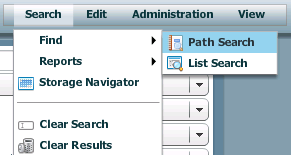
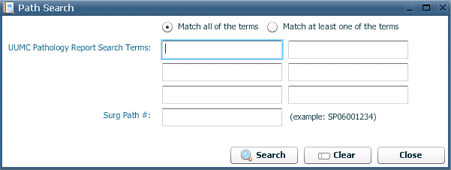
Fill in the appropriate keyword search terms in the UUMC Pathology Report Search Terms fields on the window.
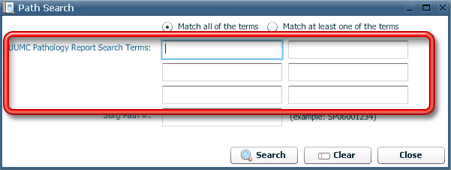
Select the appropriate radio button whether you wish your search to only find records that contain ALL of the terms entered or if you wish to find any records that contain at least one of these terms.
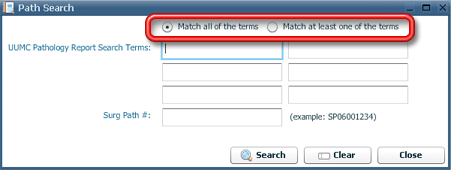
If you have a specific path report number to search for, enter that number in the Surg Path # field.
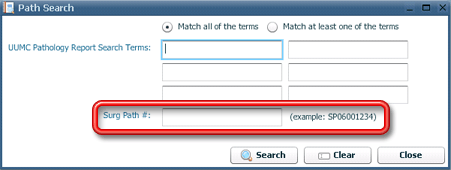
Click search
.
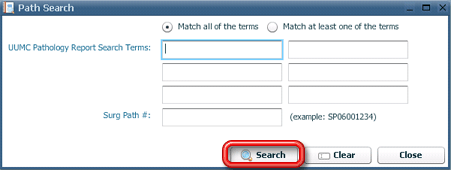
A dialog will appear, reminding you that the results of the search will include all specimens collected from patients with path reports that match the search terms specified, not just the specific specimens whose collection is related to the path report. Click OK to clear the dialog. The results of the search will be displayed in the search pane.
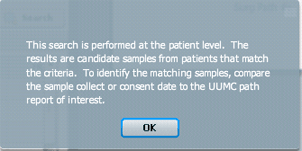
You may clear the search results by selecting Search-Clear Results in the application menu bar.
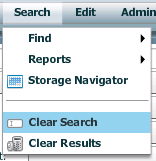
You may keep your results and run a separate pathology report keyword query which will combine the results of the just completed query with the results of the new query into a single list by clicking on the Keep search results? checkbox in the lower right corner of the List View after running the first query.




